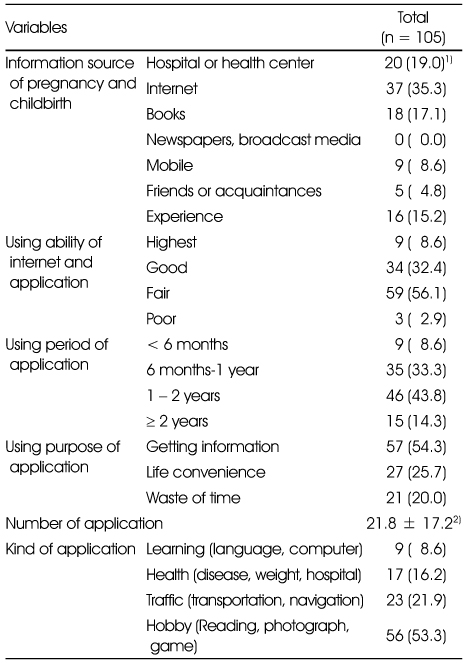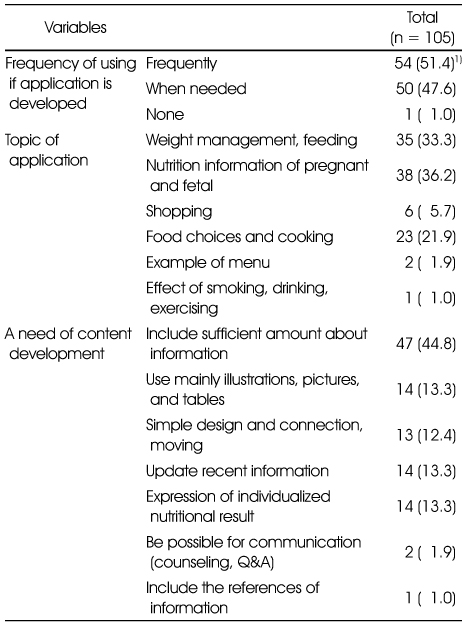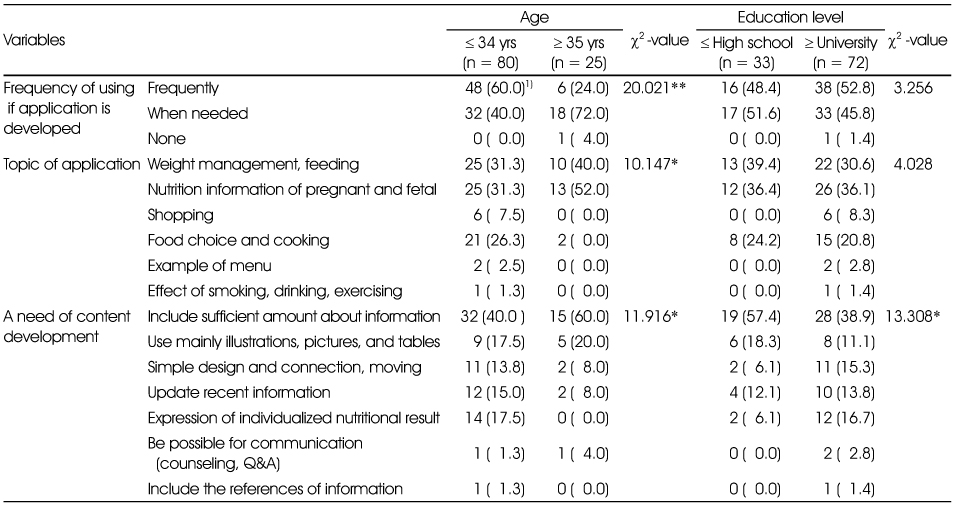References
1. Abu-Saad K, Fraser D. Maternal nutrition and birth outcomes. Epidemiol Rev 2010;32:5–25.
2. Ahn HS, Lee YM, Oh Yj. Perception and service needs about nutrition education of pregnant and lactating -to compare with pregnant and lactating women, health specialist and college women. Korean J Community Nutr 2006;11(3):327–337.
3. Cho JH, Kim SB, Kim SK, Kim MH, Kim GS, Kim SN, Kim SY, Kim JW. Development of 'children's food avatar' application for dietary education. Korean J Community Nutr 2013;18(4):299–311.
4. Choi BS, Lee IS, Shin JJ, Lim WK, Park MH. Factors affecting dietary & nutrients intake during the first, second, and third trimesters and pregnancy outcome. Korean J Diet Cult 2001;16(3):203–214.
5. Choi HM. Nutrition in pregnancy. Korean J Obstet Gynecol 2008;51(5):481–491.
6. Choi JH, Han HJ, Hwang JH, Chung SR, Moon HM, Moon IP, Cha KJ, Choi HS, Oh JE. Meta analysis of clinical studies of pregnancy and delivery in elderly gravida. Korean J Obstet Gynecol 2006;49(2):293–308.
7. Christian P, Khatry SK, Katz J, Pradhan EK. Effects of alternative maternal micronutrient supplements on low birth weight in rural Nepal: double blind randomized community trial. BMJ 2003;326(7389):571–576.
8. Gartner. Gartner says android to become No. 2 worldwide mobile operating system in 2010 and challenge symbian for No. 1 position by 2014 2010. cited 2010 September 1. Available from
http://gartner.com/it/page.jsp?id=1434613.
9. Han JS, Jeong JH. A web-based internet program for nutritional counseling and diet management of patient with diabetes mellitus. J Korean Soc Food Sci Nutr 2004;33(1):114–122.
10. Han YS, Lee SS. Association of nutrient intake and pregnancy outcome with gestational weight gain. Korean J Nutr 2010;43(2):141–151.
11. Health Insurance Review and Assessment Service. Evaluation and follow up report on cesarean section in Korea 2009.
12. Ibrahim M, Forsyth S. Nutritional interactions between mother and fetus. Pract Midwife 2002;5(10):10–17.
13. Joung HJ, Choi BS, Chin JJ, Yoon SD, Yoon H. The dietary intake of pregnant women in Daegu area. Korean J Community Nutr 2003;8(4):538–546.
14. Kim IS. A nutrition survey and development of supplemental programs for women, infants and children Daegu University; 2007. 6. MS thesis.
15. Kim JE, Park DY. A study on the actual conditions and needs for nutrition education for pregnal women in health center. Korean J Community Living Sci 2007;18(4):687–698.
16. Kim YJ, Ryou HJ, Nam HJ, Min YH, Park HR. Development and assessment of maternal and child nutrition educationmaterials for health center use. J Korean Diet Assoc 2004;10(4):428–441.
19. Koo J, Choi K. Status and needs for nutrition services for infants and preschoolers among public health center workers and infants mothers. Korean J Community Nutr 2001;6(3):354–360.
20. Lee KH, Her ES. A Study on the Development of a computer-assisted program for elementary school foodservice(I). Korean J Community Nutr 2000;5(2):208–216.
21. Lee SL, Chang YK. A study of health related factors and food habits during pregnancy of full-term and preterm delivery. J Korean Diet Assoc 2008;14(1):77–86.
22. Lhm JH, Kim HW, Kim YS. A study of the monthly weight gains of noncomplicated pregnancies. Korean J Perinatol 2002;13(2):135–140.
23. Moon JY, Hahn WH, Shin KS. Changes of maternal age distribution in live births and incidence of low birth weight infants in advanced maternal age group in Korea. Korean J Perinatol 2011;22(1):30–36.
24. Park JC, Hwang DG, Park KS, Lim KA. Design and implamentation of diabetes management system based in PDA in the wireless internet enviroment. J Korea Academic-Industrial Cooperation Soc 2007;8(6):1513–1518.
25. Park JH, Kim SB, Cho KH, Choue RW. Maternal nutritional status at the end of pregnancy, and correlation among pregnancy weight gain, birth weight and serum leptin levels. Korean J Nutr 2006;39(5):467–475.
26. Siega-Riz AM, Herrmann TS, Savitz DA, Thorp JM. Frequency of eating during pregnancy and its effect on preterm delivery. Am J Epidemiol 2001;153(7):647–652.
27. Seo YM, Lee YJ. Analysis of educational smartphone applications and mobile educational services trends. J Korean Assoc Comput Educ 2010;14(2):9–13.
28. Shin SY. A study on the effect of personal characteristics and the innovative service characteristics of Smartphones on receptive attitude Hong-Ik University; 2010. 1–48.
MS thesis.
29. Swensen AR, Harnack LJ, Ross JA. Nutritional assessment of pregnant women enrolled in the special supplemental program for women, infants and children (WIC). J Am Diet Assoc 2001;101(8):903–908.
30. Szwajcer EM, Hiddink GJ, Koelen MA. Nutrition awareness and pregnancy: Implications for the life course perspective. Eur J Obstet Gynecol Reprod Biol 2007;135:58–64.
31. Thame M, Wilks RJ, McFarlane-Anderson N. Relationship between maternal nutritional status and infant's weight and body proportions at birth. Eur J Clin Nutr 1997;51(3):134–138.
32. Verbeke W, De Boudeaudhuij I. Dietary behavior of pregnant versus non pregnant women. Appetite 2007;48:78–86.
33. Williamson CS. Nutrition in pregnancy. Nutr Bull 2006;31:28–59.
34. Woo HK, Cho YT. 'Smart Health', Leading a Change to Healthy Life : Policy Issues. Health Welf Policy Forum 2013;199:70–81.
35. Yu CH. A study on the fat and fatty acid intake of college women evaluated throuhg internet nutritional assessment system. Korean J Nutr 2007;40(1):78–88.





